Lilium candidum
| Lilium candidum | |
|---|---|
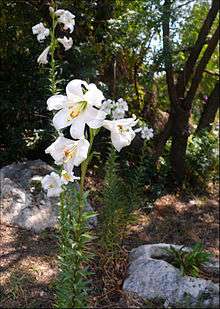 | |
| Scientific classification | |
| Kingdom: | Plantae |
| (unranked): | Angiosperms |
| (unranked): | Monocots |
| Order: | Liliales |
| Family: | Liliaceae |
| Genus: | Lilium |
| Species: | L. candidum |
| Binomial name | |
| Lilium candidum L. | |
| Synonyms[1] | |
| |
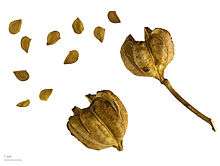
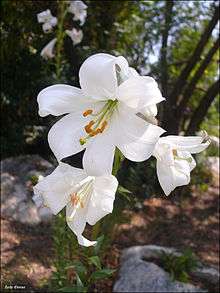
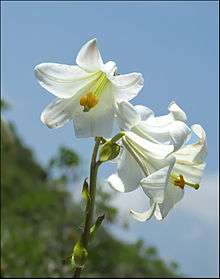
Lilium candidum, the Madonna lily,[2][3] is a plant in the true lily family. It is native to Balkans and the Middle East, and naturalized in other parts of Europe (France, Italy, Ukraine, etc.) as well as in North Africa, the Canary Islands, Mexico, and other places.[1][4] It forms bulbs at ground level, and unlike other lilies, has a basal rosette of leaves through the winter, which die back in summer. A leafy flower stem, typically up to 1.2 metres (3 ft 11 in) high, sometimes up to 2 metres (6 ft 7 in) high, emerges in late spring and bears sweetly and headily fragrant flowers in summer. Flowers are white, flushed yellow at the base.[5][6][7][8][9]
It has long been cultivated, but is susceptible to virus diseases of lilies, and to Botrytis fungus. One possible way to avoid problems with viruses is to grow plants raised from seed.
Gallery
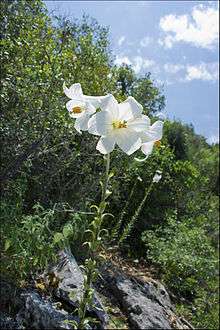 Flowers of Lilium candidum |
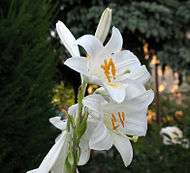 Flowers of Lilium candidum |
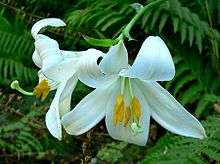 Flowers of Lilium candidum |
Madonna Lilies in art and culture
The Madonna lily is often described as being the basis of the fleur de lis, though the shape of this stylised flower more strongly resembles that of a flag iris.
Madonna lilies are depicted in a fresco at the Minoan palace of Knossos.
The Madonna Lily symbolizes purity for Roman Catholics. Medieval depictions of the Blessed Virgin Mary often show her holding these flowers.
There are translations of the Bible that identify the Hebrew word Shoshannah as 'lily' in Song of Songs ("As the lily among thorns, so is my love among the daughters." Song of Songs 2:2 (KJV)), not as a rose as is customary to translate. For example, Abraham ibn Ezra describes it as a white flower, which has a good fragrance, and has a six-petal flower and six stamens. But its identity is uncertain, because it does not fit with the description as "the lily of the valleys", because mostly it grows in the mountains.
The Bible describes King Solomon's Temple as having designs of Madonna lilies on the columns[10] and on the brazen Sea (Laver). [11]
Toxicity
Cats
Cats are extremely sensitive to lily toxicity and ingestion is often fatal;[12][13][14] households and gardens which are visited by cats are strongly advised against keeping this plant or placing dried flowers where a cat may brush against them and become dusted with pollen which they then consume while cleaning.[15] Suspected cases require urgent veterinary attention.[16] Rapid treatment with activated charcoal and/or induced vomiting can reduce the amount of toxin absorbed (this is time-sensitive so in some cases vets may advise doing it at home), and large amounts of fluid by IV can reduce damage to kidneys to increase the chances of survival.[16]
References
- 1 2 Kew World Checklist of Selected Plant Families
- ↑ "BSBI List 2007". Botanical Society of Britain and Ireland. Archived from the original (xls) on 2015-02-25. Retrieved 2014-10-17.
- ↑ "Lilium candidum". Natural Resources Conservation Service PLANTS Database. USDA. Retrieved 24 January 2016.
- ↑ Altervista Flora Italiana, Giglio bianco di S. Antonio, Madonna lily, Lilium candidum L.
- ↑ Tutin, T.G. & al. (eds.) (1980). Flora Europaea 5: 1-452. Cambridge University Press.
- ↑ Davis, P.H. (ed.) (1984). Flora of Turkey and the East Aegean Islands 8: 1-632. Edinburgh University Press, Edinburgh.
- ↑ Danin, A. (2004). Distribution Atlas of Plants in the Flora Palaestina area: 1-517. The Israel Academy of Sciences and Humanities, Jerusalem.
- ↑ Ikinci, N., Oberprieler, C. & Güner, A. (2006). On the origin of European lilies: phylogenetic analysis of Lilium section Liriotypus (Liliaceae) using sequences of the nuclear ribosomal transcribed spacers. Willdenowia 36: 647-565.
- ↑ Dimpoulos, P., Raus, T., Bergmeier, E., Constantinidis, T., Iatrou, G., Kokkini, S., Strid, A., & Tzanoudakis, D. (2013). Vascular plants of Greece. An annotated checklist: 1-372. Botanic gardens and botanical museum Berlin-Dahlem, Berlin and Hellenic botanical society, Athens.
- ↑ 1 Kings 7:19
- ↑ 1 Kings 7:26
- ↑ Frequently Asked Questions No Lillies For Cats.
- ↑ Lily toxicity in the cat. Kevin T. Fitzgerald, PhD, DVM, DABVP.
- ↑ The trouble with lilies: fabulous but fickle The Telegraph.
- ↑ The Valentine bouquet that killed my cats: Mother's Day warning on lethal lilies Daily Mail.
- 1 2 Lily Poisoning in Cats. Pet MD.
- The European Garden Flora (1986)
- Garden Bulbs for the South (1994)
External links
| Wikispecies has information related to: Lilium candidum |
| Wikimedia Commons has media related to Lilium candidum. |